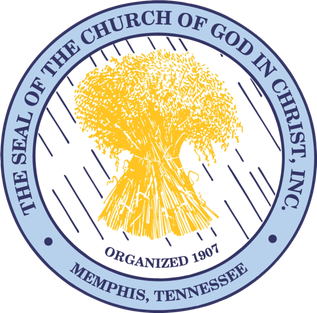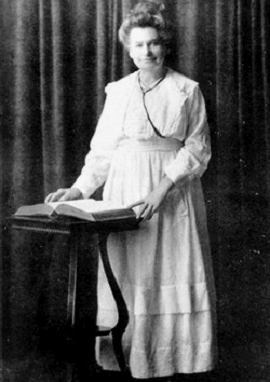Pentecostalism or classical Pentecostalism is a Protestant Charismatic Christian movement that emphasizes direct personal experience of God through baptism with the Holy Spirit. The term Pentecostal is derived from Pentecost, an event that commemorates the descent of the Holy Spirit upon the Apostles and other followers of Jesus Christ while they were in Jerusalem celebrating the Feast of Weeks, as described in the Acts of the Apostles.

The Church of God in Christ (COGIC) is an international Holiness–Pentecostal Christian denomination, and a large Pentecostal denomination in the United States. Although an international and multi-ethnic religious organization, it has a predominantly African-American membership based within the United States. The international headquarters is in Memphis, Tennessee. The current Presiding Bishop is Bishop John Drew Sheard Sr., who is the Senior Pastor of the Greater Emmanuel Institutional Church of God in Christ of Detroit, Michigan. He was elected as the denomination's leader on March 27, 2021.

The World Assemblies of God (AG), officially the World Assemblies of God Fellowship (WAGF) is a global cooperative body of over 140 Pentecostal denominations. The WAGF (originally called World Pentecostal Assemblies of God Fellowship) was established on August 15, 1989, at the International Decade of Harvest Conference. Founding delegates represented various national Pentecostal churches that were historically and theologically connected to the AG and in fraternal relationship with each other. WAGF was created to provide structure so that member denominations, which previously related to each other informally, could more easily cooperate on a global basis.

The International Pentecostal Holiness Church (IPHC) or simply Pentecostal Holiness Church (PHC) is an international Holiness-Pentecostal Christian denomination founded in 1911 with the merger of two older denominations. Historically centered in the Southeastern United States, particularly the Carolinas and Georgia, the Pentecostal Holiness Church now has an international presence. In 2000, the church reported a worldwide membership of over one million—over three million including affiliates.
The Latter Rain, also known as the New Order or the New Order of the Latter Rain, was a post-World War II movement within Pentecostal Christianity which remains controversial. The movement saw itself as a continuation of the restorationism of early Pentecostalism. The movement began with major revivals between 1948 and 1952 and became established as a large semi-organized movement by 1952. It continued into the 1960s. The movement had a profound impact on subsequent movements as its participants dispersed throughout the broader charismatic and Pentecostal movements beginning in the 1960s.
David Johannes du Plessis was a South African-born American Pentecostal minister. He is considered one of the main founders of the charismatic movement, in which the Pentecostal experience of baptism with the Holy Spirit spread to non-Pentecostal churches worldwide.

The Apostolic Church is an international Christian denomination and Pentecostal movement that emerged from the Welsh Revival of 1904–1905. Although the movement began in the United Kingdom, the largest national Apostolic Church became the Apostolic Church Nigeria. The term "Apostolic" refers to the role of apostles in the denomination's church government, as well as a desire to emulate 1st century Christianity in its faith, practices, and government.

Maria Beulah Woodworth-Etter was an American healing evangelist. Her ministry style was a model for Pentecostalism and the later Charismatic movement, earning her the title "Mother of Pentecost" in some circles.
The Assemblies of God in New Zealand is a Pentecostal denomination in New Zealand and a member of the World Assemblies of God Fellowship. In 2007, the denomination had nearly 200 congregations and preaching points and 30,000 members and adherents, mostly in the North Island, and it sends missionaries to South Asia and Oceania.

The Apostolic Faith Mission of South Africa (AFM) is a classical Pentecostal Christian denomination in South Africa. With 1.2 million adherents, it is South Africa's largest Pentecostal church and the fifth largest religious grouping in South Africa representing 7.6 percent of the population. Dr. Isak Burger has led the AFM as president since 1996 when the white and black branches of the church were united. It is a member of the Apostolic Faith Mission International, a fellowship of 23 AFM national churches. It is also a member of the South African Council of Churches.

The Assemblies of God USA (AG), officially The General Council of the Assemblies of God, is a Pentecostal Christian denomination in the United States and the U.S. branch of the World Assemblies of God Fellowship, the world's largest Pentecostal body. The AG reported 2.9 million adherents in 2022. In 2011, it was the ninth largest Christian denomination and the second largest Pentecostal denomination in the United States. The Assemblies of God is a Finished Work denomination, and it holds to a conservative, evangelical and classical Arminian theology as expressed in the Statement of Fundamental Truths and position papers, which emphasize such core Pentecostal doctrines as the baptism in the Holy Spirit, speaking in tongues, divine healing and the Second Coming of Jesus Christ.
Bible colleges affiliated with Australian Christian Churches refers to Bible colleges that are registered with Australian Christian Churches, a Pentecostal denomination. Australian Christian Churches currently has eight registered Bible colleges, that train aspiring ACC pastors, leaders, evangelists and missionaries as well as people from other denominations and other aspirations. Alphacrucis is the official ministry training college of the denomination.
Christian Life Centre is or was a name given to a number of Pentecostal churches in Australia, many of them affiliated with the Australian Christian Churches network. Hills Christian Life Centre, which has since changed its name to Hillsong Church, was one of these, and spawned other churches in Australia and around the globe.
The New Zealand Samoan Assemblies of God (SA/G) or (SAOG), officially The General Council of the Samoan Assemblies of God in New Zealand Inc. are a group of Pentecostal congregations predominantly made up of Samoan people. They are affiliated with the Samoan Assemblies of God church.

Brian Charles Houston is a New Zealand-Australian former pastor and evangelist. He was the founder and senior pastor at Hillsong Church, based in Sydney with locations around the world. He was the national president of Australian Christian Churches, the Australian branch of the Assemblies of God, from 1997 to 2009.

The Swedish Pentecostal Movement is a Pentecostal movement in Sweden. Many, but not all, of these, are members of the Pentecostal Alliance of Independent Churches, which was founded in 2001. The Pentecostal movement spread to Sweden by 1907 from the 1904–1905 Welsh Revival and the Azusa Street Revival in Los Angeles in 1906.

Pentecostalism in Australia is a large and growing Christian movement. Pentecostalism is a renewal movement within Protestant Christianity that places special emphasis on a direct personal experience of God through baptism with the Holy Spirit. It emerged from 19th century precursors between 1870 and 1910, taking denominational form from c. 1927. From the early 1930s, Pentecostal denominations multiplied, and there are now several dozen, the largest of which relate to one another through conferences and organisations such as the Australian Pentecostal Ministers Fellowship. The Australian Christian Churches, formerly known as the Australian Assemblies of God, is the oldest and longest lasting Pentecostal organisation in Australia. The AOG/ACC is also the largest Pentecostal organisation in Australia with over 300,000 members in 2018. Until 2018, Hillsong Church was one of 10 megachurches in Australia associated with the ACC that have at least 2,000 members weekly. According to the church, over 100,000 people attend services each week at the church or one of its 80 affiliated churches located worldwide.
Pentecostalism began spreading in South Africa after William J. Seymour, of the Azusa Street mission, sent missionaries to convert and organize missions. By the 1990s, approximately 10% of the population of South Africa was Pentecostal. The largest denominations were the Apostolic Faith Mission, Assemblies of God, and the Full Gospel Church of God. Another 30% of the population was made up of mostly black Zionist and Apostolic churches, which comprise a majority of South Africa's African Instituted Churches(AICs). In a 2006 survey, 1 in 10 urban South Africans said they were Pentecostal, and 2 in 10 said they were charismatic. In total, renewalists comprised one-fourth of the South African urban population. A third of all protestants surveyed said that they were Pentecostal or charismatic, and one-third of all South African AIC members said they were charismatic.
Sarah Jane Lancaster was the leader of Australia's first Pentecostal congregation. An evangelist and administrator, she established a printing press in her meeting hall to produce evangelistic tracts and pamphlets. Lancaster also published Australia's first Pentecostal magazine, Good News. Lancaster became president of the nation's earliest attempt to organise Pentecostalism into a denomination, the Apostolic Faith Mission of Australasia. Although she is recognised as the founder of Australian Pentecostalism and contributed to the unique prominence of women in the founding of Australian Pentecostal congregations, many of her doctrinal ideas were quickly abandoned as the movement developed.











